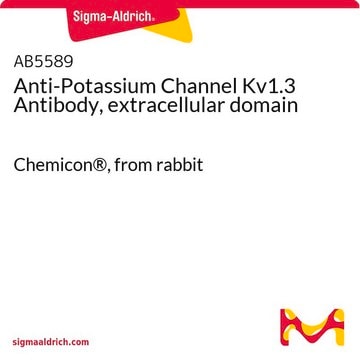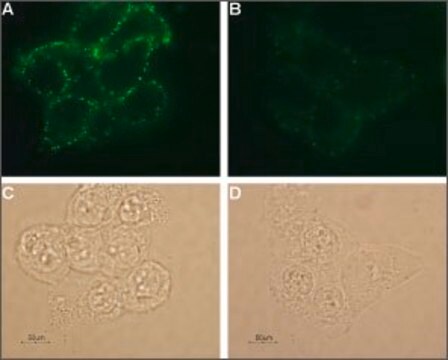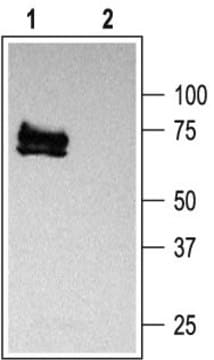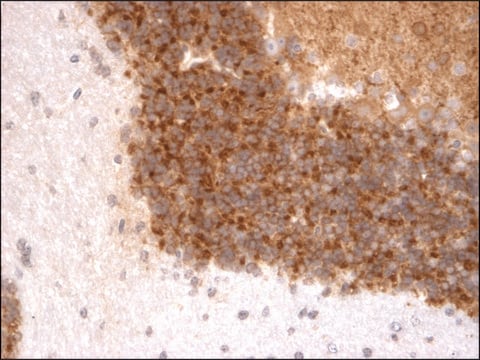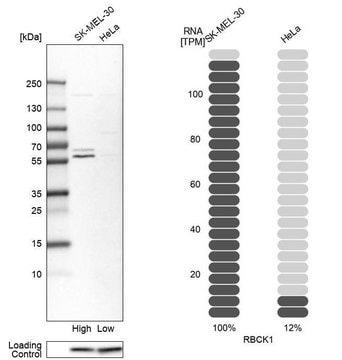P4247 Sigma-Aldrich Anti-Potassium Channel Kv1.3 (extracellular)−FITC antibody produced in rabbit is a rabbit polyclonal antibody, so it is a rabbit IgG-type antibody. Since there are no isotypes/subtypes for rabbit polyclonal IgG, the most suitable negative control would be a normal (i.e., non-immune) rabbit IgG that is conjugated to FITC. Unfortunately at this time, we do not offer an antibody such as this; however, we offer normal rabbit IgG that is either unconjugated (which could be conjugated with FITC at the end-user's facility), or conjugated to other fluorophores, e.g., 16-237 Sigma-Aldrich Normal Rabbit IgG, Alexa Fluor® 488 conjugate.
P4247
Anti-Potassium Channel Kv1.3 (extracellular)−FITC antibody produced in rabbit
affinity isolated antibody, lyophilized powder
Sinónimos:
Anti-Kcna3, Anti-Voltage-gated Potassium Channel KV1.3
Seleccione un Tamaño
851,00 €
Seleccione un Tamaño
About This Item
851,00 €
Productos recomendados
origen biológico
rabbit
Nivel de calidad
conjugado
FITC conjugate
forma del anticuerpo
affinity isolated antibody
tipo de anticuerpo
primary antibodies
clon
polyclonal
Formulario
lyophilized powder
reactividad de especies
rat, human, mouse
técnicas
flow cytometry: 0.5-5 μg/test using Jurkat T-cells
western blot: 1:200-1:500 using rat brain membranes
Nº de acceso UniProt
Condiciones de envío
dry ice
temp. de almacenamiento
−20°C
modificación del objetivo postraduccional
unmodified
Información sobre el gen
human ... KCNA3(3738)
mouse ... Kcna3(16491)
rat ... Kcna3(29731)
Descripción general
Inmunógeno
Aplicación
Forma física
Cláusula de descargo de responsabilidad
¿No encuentra el producto adecuado?
Pruebe nuestro Herramienta de selección de productos.
Código de clase de almacenamiento
13 - Non Combustible Solids
Clase de riesgo para el agua (WGK)
WGK 3
Punto de inflamabilidad (°F)
Not applicable
Punto de inflamabilidad (°C)
Not applicable
Elija entre una de las versiones más recientes:
Certificados de análisis (COA)
¿No ve la versión correcta?
Si necesita una versión concreta, puede buscar un certificado específico por el número de lote.
¿Ya tiene este producto?
Encuentre la documentación para los productos que ha comprado recientemente en la Biblioteca de documentos.
Artículos
Flow cytometry dye selection tips match fluorophores to flow cytometer configurations, enhancing panel performance.
Troubleshooting guide offers solutions for common flow cytometry problems, ensuring improved analysis performance.
Protocolos
Explore our flow cytometry guide to uncover flow cytometry basics, traditional flow cytometer components, key flow cytometry protocol steps, and proper controls.
Learn key steps in flow cytometry protocols to make your next flow cytometry experiment run with ease.
-
Is there an isotype control for this Ab
1 respuesta-
¿Le ha resultado útil?
-
Filtros activos
Nuestro equipo de científicos tiene experiencia en todas las áreas de investigación: Ciencias de la vida, Ciencia de los materiales, Síntesis química, Cromatografía, Analítica y muchas otras.
Póngase en contacto con el Servicio técnico